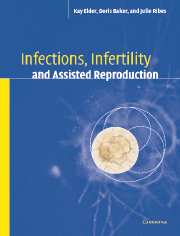Book contents
- Frontmatter
- Contents
- Foreword
- Preface
- Acknowledgements
- Part I Overview of microbiology
- Part II Infections in reproductive medicine
- 7 Genital ulcer diseases
- 8 Vaginitis syndromes
- 9 Genital human papillomavirus (HPV) infections
- 10 Urethritis and cervicitis syndromes
- 11 Pathology of the upper genitourinary tract
- 12 Cytomegalovirus and blood-borne viruses
- Part III Infection and the assisted reproductive laboratory
- Index
12 - Cytomegalovirus and blood-borne viruses
from Part II - Infections in reproductive medicine
Published online by Cambridge University Press: 29 October 2009
- Frontmatter
- Contents
- Foreword
- Preface
- Acknowledgements
- Part I Overview of microbiology
- Part II Infections in reproductive medicine
- 7 Genital ulcer diseases
- 8 Vaginitis syndromes
- 9 Genital human papillomavirus (HPV) infections
- 10 Urethritis and cervicitis syndromes
- 11 Pathology of the upper genitourinary tract
- 12 Cytomegalovirus and blood-borne viruses
- Part III Infection and the assisted reproductive laboratory
- Index
Summary
Although cytomegalovirus (CMV), hepatitis B, C, D viridae (HBV, HCV, HDV), human T-lymphotrophic virus (HTLV) and human immunodeficiency virus (HIV) are not associated with genital tract manifestations, they may be considered as sexually transmitted diseases. These agents pose a particular risk in assisted reproductive technologies because of their potential for transmission to staff, to other patients, and to children born as a result of treatment, particularly via cycles that involve the use of donor gametes. They are responsible for a wide spectrum of clinical illnesses involving multiple organ systems, and all have been recognized to be more prevalent in populations attending STD clinics than in the general population.
The infectious agents of CMV, HIV, HTLV, HBV, HCV and HDV can persist in the blood unknown to the carrier, who may be asymptomatic; they can also be transmitted via other body fluids, including:
cerebrospinal fluid (CSF)
pleural fluid
breast milk
amniotic fluid
peritoneal fluid
pericardial fluid
synovial fluid
vaginal secretions
semen
any other fluid containing visible blood, as well as all unfixed tissues, organs, and parts of bodies.
Blood-borne virus (BBV) transmission can occur via:
sexual intercourse
sharing needles/syringes
re-use of unsterilized or inadequately sterilized injection equipment
skin puncture by blood-contaminated sharp objects such as needles, instruments or glass
childbirth – before or during birth, or through breast feeding
- Type
- Chapter
- Information
- Infections, Infertility, and Assisted Reproduction , pp. 262 - 302Publisher: Cambridge University PressPrint publication year: 2004



